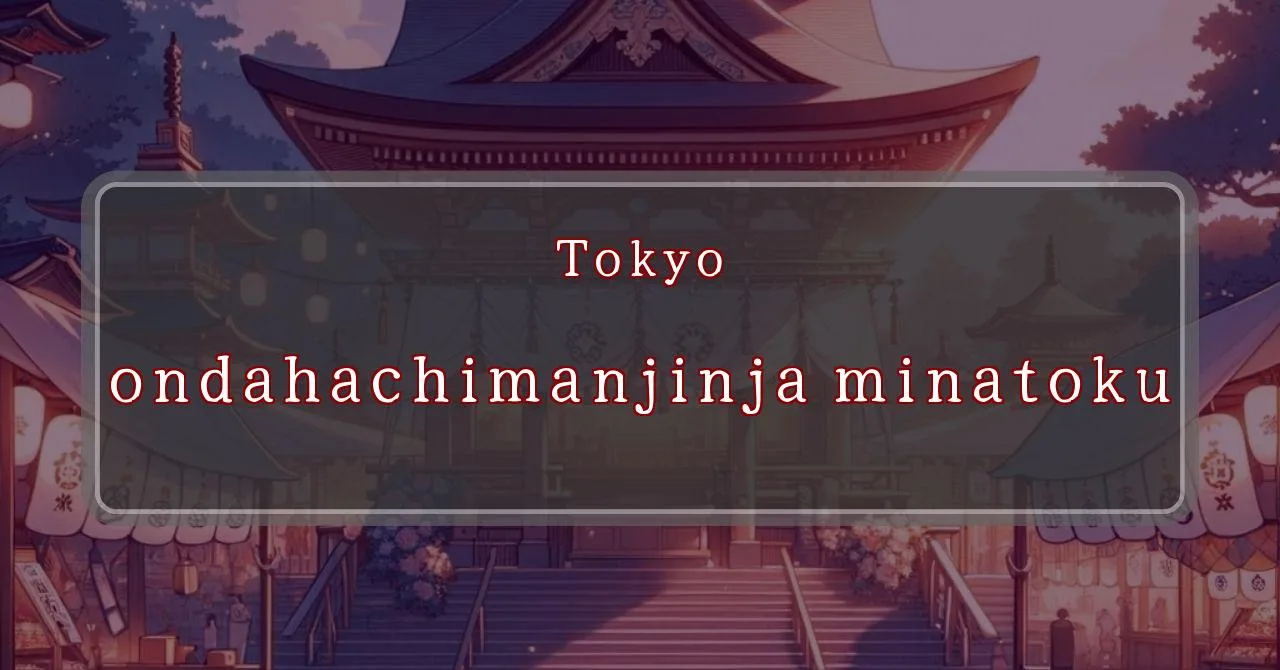Gleaming lights dance at Tokyo’s summer festival
Basic Information
Mita Hachiman Shrine is a Shinto shrine located in Mita, Minato, Tokyo, Japan. It is dedicated to the god Hachiman, the patron deity of warriors and the god of archery.
- Address: 3-7-16 Mita, Minato-ku, Tokyo 108-0073
- Phone Number: 03-3451-4687
- Access: A 10-minute walk from JR Tamachi Station Mita Exit (West Exit), a 10-minute walk from Takanawa Gateway Station, a 7-minute walk from Toei Mita Line Mita Station A3 Exit, and a 5-minute walk from Toei Asakusa Line 泉岳寺 Station A3 Exit.
- Festival Days: August 3 (Thu), August 4 (Fri), and August 5 (Sat), 2024
Main Events and Attractions of the Festival
The Mita Hachiman Shrine Festival is a lively and colorful event that attracts many visitors each year. The festival features a variety of events and attractions, including:
Mikoshi Procession
One of the highlights of the festival is the mikoshi procession. A mikoshi is a portable shrine that is carried through the streets by a team of people. The mikoshi of Mita Hachiman Shrine is particularly large and impressive, and it is carried by a team of over 100 people. The procession is a lively and energetic event, and it is a great opportunity to experience the traditional culture of Japan.
Kagura Performance
Kagura is a traditional Japanese dance that is performed at Shinto shrines. The kagura performance at Mita Hachiman Shrine is a beautiful and graceful dance that tells the story of the shrine’s founding. The performance is accompanied by traditional Japanese music, and it is a great opportunity to learn about the history and culture of Japan.
Food Stalls
No Japanese festival is complete without food stalls! At the Mita Hachiman Shrine Festival, there will be a variety of food stalls selling a wide range of delicious Japanese food. From traditional dishes like yakitori and takoyaki to more modern fare like crepes and ice cream, there is something for everyone to enjoy.
Games and Activities
In addition to the mikoshi procession, kagura performance, and food stalls, the Mita Hachiman Shrine Festival also features a variety of games and activities for children and adults alike. These include traditional Japanese games like ring toss and goldfish scooping, as well as more modern games like face painting and balloon animals. There is something for everyone to enjoy at the Mita Hachiman Shrine Festival!
Blessings and Deities
Mita Hachiman Shrine is dedicated to the god Hachiman, the patron deity of warriors and the god of archery. Hachiman is also revered as a god of agriculture, commerce, and prosperity. The shrine is said to have been founded in 709 AD by Emperor Monmu, who prayed to Hachiman for victory in battle. The shrine has been rebuilt and renovated several times over the centuries, but the current honden (main shrine building) dates back to 1628.
- Deity: Hachiman
- Blessings: Victory in battle, agriculture, commerce, prosperity
Origin and History
The origins of Mita Hachiman Shrine are unclear, but it is believed to have been founded in the 8th century. The shrine was originally located in the Mita area of Tokyo, but it was moved to its current location in 1628. The shrine has been rebuilt and renovated several times over the centuries, but the current honden (main shrine building) dates back to 1628.
- Founded: 8th century
- Moved to current location: 1628
- Rebuilt and renovated: Several times over the centuries
Tips and Notes for Visitors
Mita Hachiman Shrine is a popular tourist destination, especially during the annual festival in August. Here are some tips and notes for visitors:
- The shrine is open daily from 9:00 AM to 5:00 PM.
- Admission is free.
- The shrine is accessible by train or bus.
- There is a parking lot available for visitors.
- The shrine is a popular spot for weddings and other ceremonies.
Parking Information
There is a parking lot available for visitors to Mita Hachiman Shrine. The parking lot is located next to the shrine, and it can accommodate up to 50 cars. The parking fee is 500 yen per day.
- Location: Next to the shrine
- Capacity: 50 cars
- Fee: 500 yen per day
Popular Stalls and Food Carts in Recent Years
| Type of Stall | Description |
|---|---|
| Takoyaki | A staple at Japanese festivals. Characterized by a crispy outside and a creamy inside. |
| Jaga Butter | A simple yet popular snack of hot potatoes lavishly topped with melted butter. |
| Baby Castella | Small castella cakes, sweet and fluffy treats enjoyed by children and adults alike. |
| Grilled Ayu with Salt | Fresh ayu fish grilled whole with salt, a savory taste of Japanese summer. |
| Shaapin | A unique gourmet item influenced by foreign cuisine, with a chewy skin wrapping the filling. |
| Okonomiyaki | A Japanese grilled dish where you often choose your own ingredients for a personalized flavor. |
| Cotton Candy | A fluffy, sweet snack that’s extremely popular with children. |
| Chocolate Banana | A banana coated in chocolate, a fun and visually appealing dessert. |
| Kushiyaki | Various types of ingredients skewered and grilled, an easy-to-enjoy snack. |
| Yakisoba | Fried noodles mixed with a special sauce, a fast food favorite in Japan. |



